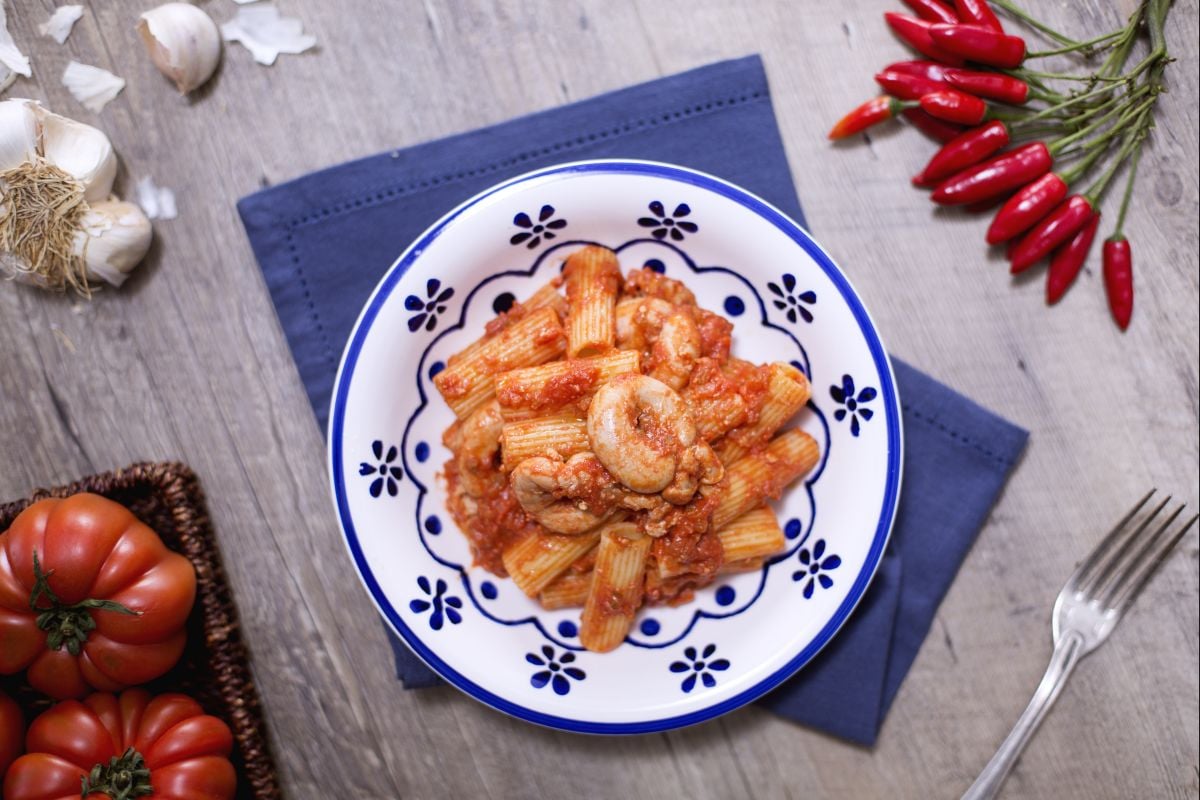Rigatoni with pajata

- Lactose Free
- Vegetarian
- Vegan
- Energy Kcal 610
- Carbohydrates g 70.9
- of which sugars g 6.9
- Protein g 36
- Fats g 16.8
- of which saturated fat g 4.87
- Fiber g 3.9
- Cholesterol mg 77
- Sodium mg 426
- Difficulty: Easy
- Prep time: 30 min
- Cook time: 2 h 40 min
- Serving: 4
- Cost: Low
PRESENTATION
Rigatoni with pajata is one of those bold dishes that truly speaks to the heart of Rome. It's from the Lazio region, and anyone who loves traditional Roman pasta knows it’s something special. Not on every menu these days, but in old-school trattorias or spots in the Testaccio district? It still shows up, packed with history and flavor. The star? The pajata—veal intestine—slow-cooked in a rich tomato sauce until it becomes tender and perfectly blends with the rigatoni. Really, folks in Rome have been making this for generations, turning a humble, everyday ingredient into something that stands out for its tangy sauce and moist texture. It’s like a taste of Roman food culture, the kind you see in classic Italian movies—like those with Alberto Sordi—where food brings everyone together for laughs and a big meal.
Some folks might think rigatoni with pajata is a bit out there, but for anyone into Roman cuisine recipes that go beyond the usual carbonara or amatriciana, it’s a real treat. The tomato sauce soaks into the pasta, and the pajata gives a creamy, almost sweet flavor. Not your typical meat sauce. Roman cooks really respect simple things, making the most out of what they have—this dish is a great example of those old-school traditions. Versions pop up all over Lazio, but the real deal? It happens in Rome, especially near the old markets and butcher shops. Eating this feels like getting a true slice of the city, with its big flavors and love for offbeat ingredients. For anyone curious about Roman offal dishes or searching for an authentic Italian pasta that packs a punch, this is the kind of meal worth talking about, sharing, and maybe even hunting down next time you’re in Italy. It's all about savoring the hearty taste of tradition and the warmth of Roman hospitality. Honestly, it makes every bite a journey through time. Can't go wrong with that.
You might also like:
- INGREDIENTS
- Rigatoni 11.3 oz (320 g)
- Pagliata 1.1 lbs (500 g) - calf
- Tomato purée 2 cups (500 g)
- White onions 1.1 oz (30 g)
- Celery 1.75 oz (50 g)
- Garlic 0.5 oz (15 g)
- White wine ¾ cup (200 g)
- Extra virgin olive oil 2 tbsp (30 g)
- Coarse salt 1 ½ tsp (10 g)
- Green Peperoncino 1 tsp (5 g)
How to prepare Rigatoni with pajata

To prepare rigatoni with pajata, first take care of the sauce, starting with the How to make the soffritto by cleaning the onion and cutting it first vertically and then horizontally 1: this way, thanks to the crisscross cuts, you'll be able to chop it as finely as possible 2; then move on to the celery, which you will cut into strips 3

and then into small pieces 4. In a large saucepan, pour in some oil along with the minced onion and celery 5, also add the clove of garlic in its skin (i.e., without peeling it) 6 and let it flavor for a few minutes over low heat, stirring continuously.

After carefully washing the pajata without breaking it, already peeled and tied by the butcher, add it to the pot, letting it sauté for 10 minutes 7, then deglaze with white wine 8 and let it dry, remembering to remove the garlic 9.

When the liquid has completely evaporated, add the tomato puree 10, coarse salt 11, and chili pepper 12.

and cover with a lid 13, letting it cook for about 2 hours over low heat, stirring occasionally; only if necessary, you can add a bit of water. When the pajata is near the end of cooking, move on to the pasta, which you will drop in plenty of boiling salted water 14; once ready, drain it and pour it directly into the cooking pot 15.

Then give a brief high flame to flavor the pasta 16 and if needed, adjust the salt 17; then serve your rigatoni with pajata while still hot 18!